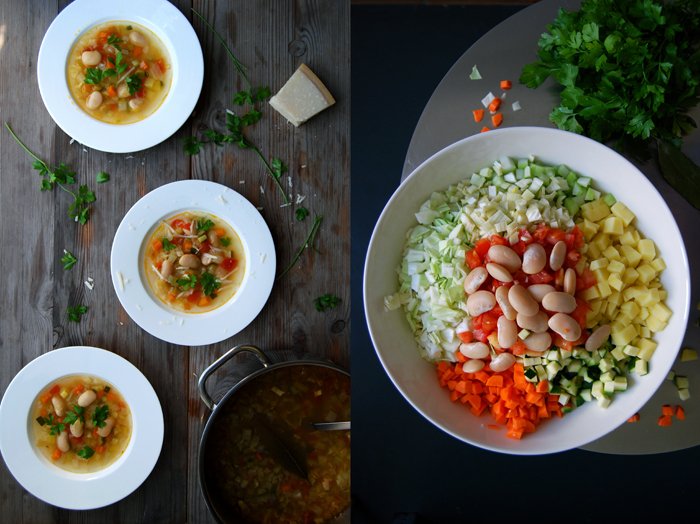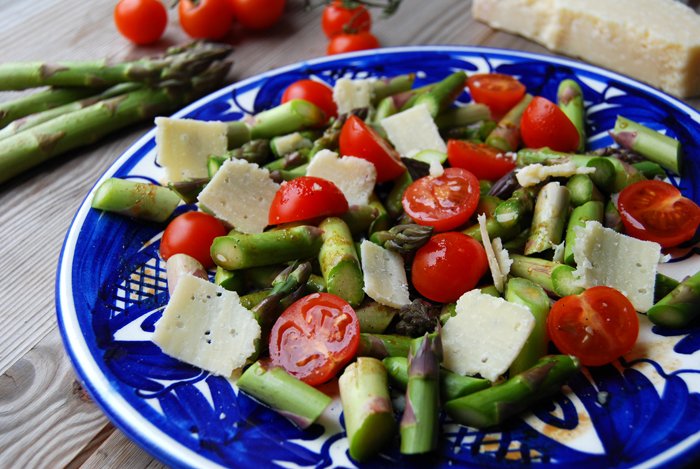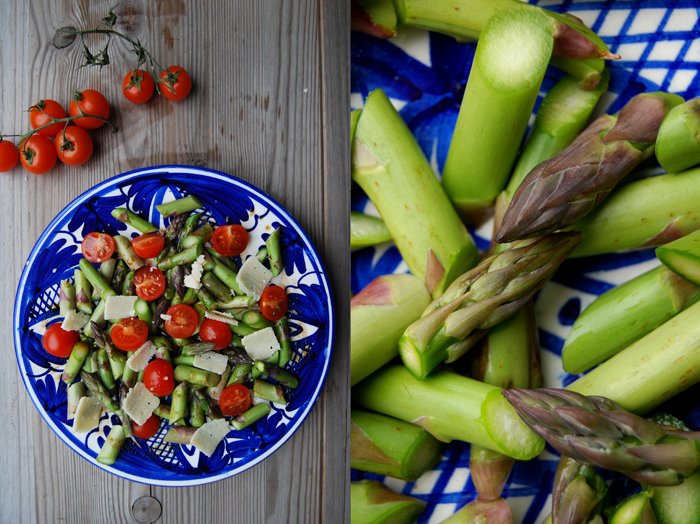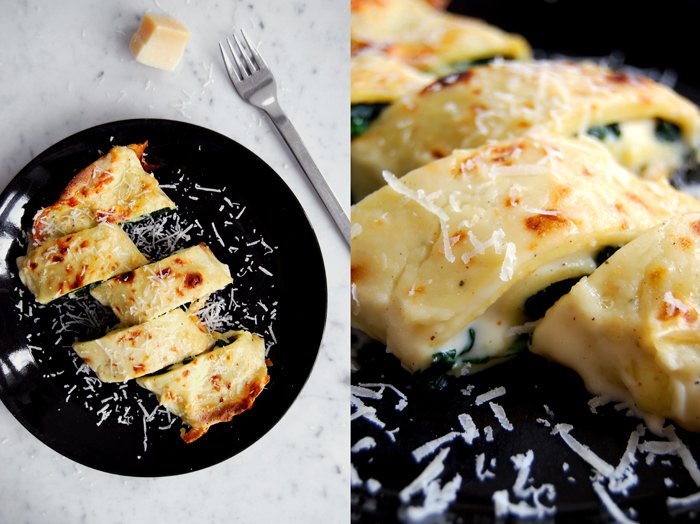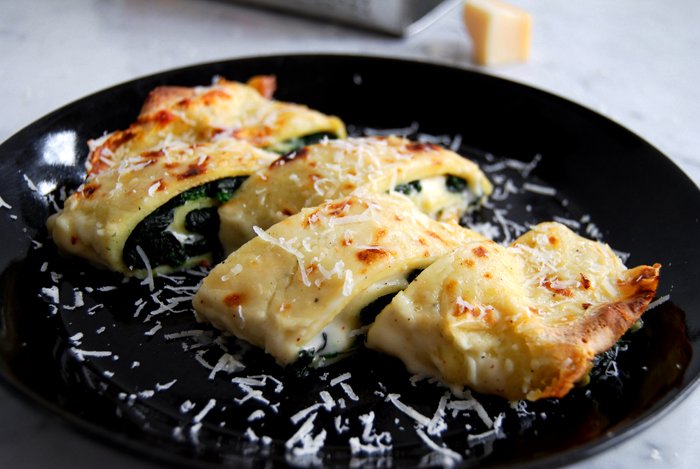Minestrone alla Genovese with Zucchini, Beans and Parmesan
A minestrone simmering on the cooker puts me a into a comfortable mood, the smell and taste reminds me of the kitchens of all the great cooks in my family and it makes me feel at home! I'm very lucky as I'm surrounded by a few women who have mastered the art of a good minestrone.
My Maltese granny Edith cooks her vegetable soup with courgette, marrows and potatoes and I learnt from her that a little parmesan sprinkled on top makes all the difference. The cheese melts into the warming broth and adds a hearty touch to it. My mother goes with the seasons and uses whatever her vegetable garden offers. Beans, cabbage, peas, potatoes, carrots, the list is long and inspiring. She walks through her garden with a big basket in her hand and picks the fruits and vegetables that fit her mood. She taught me to chop everything into small cubes and blanch each vegetable in the broth separately. This way you avoid some vegetables becoming too soggy and soft while others stay crunchy. I don't always do this, sometimes I cook it all at once, it depends on the texture I want to achieve.
My minestrone never tastes the same, I like to try out new variations and this one was inspired by the north of Italy, the Minestrone alla Genovese! This warming soup is so rich in flavours, cooked with cabbage, dried butter beans, zucchini, carrots, potatoes, fennel, tomatoes, celery and leak, I listened to both women to be rewarded with a very satisfying result, I chopped the vegetables into little cubes which would have pleased my mother but I cooked them all at once for not more than 20 minutes. I just cooked the soaked dried butter beans separately as they needed about an hour. After I filled my flavourful soup into the plates, I scattered some parsley leaves and grated Parmesan over it, thanks to Edith!
When I cook minestrone, I cook lots of it as I like to put a few portions in the freezer for a quick lunch or dinner. Once the chopping is done, it just needs another half an hour, so you might as well prepare a bit more. You could also add some little pasta like Anellini or Risini to make the dish a bit richer.
Minestrone alla Genovese
For a large pot of around 4l / 8.5 pints of minestrone (for about 8-12 people) you need
big dried butter beans, soaked over night, 200g / 7 ounces
large onion, chopped, 1
white cabbage, cut into small cubes, 200g / 7 ounces
carrots, cut into small cubes, 150g / 5.5 ounces
zucchini, cut into small cubes, 150g / 5.5 ounces
leek, cut into small cubes, 100g / 3.5 ounces
potatoes, cut into small cubes, 200g / 7 ounces
fennel bulb, cut into small cubes, 100g / 3.5 ounces
large celery stalk, cut into small cubes, 1
large tomatoes, cut into small cubes, 2
broth, hot, 2.8l / 6 pints
garlic, crushed, 3 cloves
bay leaf 1
salt and pepper
olive oil
Parmesan, grated, for the topping
fresh parsley leaves, a handful, for the topping
In a large pot, cook the soaked beans for about an hour or until al dente, drain and set aside.
In a large pot, heat a splash of olive oil and fry the onion for a few minutes on medium heat till golden and soft. Add the garlic and cook for 1 minute. Add a little more oil and the chopped vegetables, stir and cook for 1-2 minutes. Add the hot broth, the beans and bay leaf. Season with salt and pepper and cook for 20 minutes. Season to taste and serve sprinkled with Parmesan and parsley.
Parmesan Risotto with crisp Fava Beans
When my sister told me abut her latest risotto discovery from her trip to Italy, she sounded so thrilled that I couldn't wait to get the pot on the cooker. She was talking about a parmesan risotto which by itself isn't necessarily spectacular but this one is different. It's made with bigger pieces of cheese which are stirred into the creamy rice when the risotto is done. The parmesan melts, partly, but a few crumbs keep their crunchy center which makes it taste stronger, more concentrated. I was absolutely impressed, this method of preparation lifts parmesan risotto onto another level!
I had some fava beans left on my window sill which I added to the rice, I prefer to have some vegetables with my risotto. Be it a simple salad or some sautéed greens on the side, I need my vitamins as much as my carbohydrates! I fried the beans with some garlic, deglazed them with white wine and let them simmer for a few minutes. I wanted them al dente, a crisp topping for my smooth risotto!
I cooked the risotto with the water I had used to cook asparagus in a few days ago. It's a light broth which I always keep and freeze, great for recipes which need a soft vegetable aroma.
Parmesan Risotto with Fava Beans
For 4-5 people you need
Arborio rice 400g / 15 ounces
medium size onion, chopped finely, 2
broth around 2200ml / 4.5 pints
Parmesan, cut into 1cm / 1/2" cubes, 80g / 3 ounces
fava beans, peeled out of their pods and shells, 800g / 28 ounces (around 300g / 10.5 ounces peeled beans)
garlic, roughly chopped, 1 clove
white wine 120ml / 4 ounces
salt and black pepper
olive oil for frying
butter 2 tablespoons
In a large pan, heat a little olive oil and 1 tablespoon of butter, add the garlic and beans and fry on a medium heat for a few minutes until golden. Deglaze with half of the wine and let it cook for a minute. Season with salt and pepper and add the rest of the wine, close with a large lid and let it simmer for 5 minutes or until al dente. Season with salt and pepper to taste.
In a large pot, fry the onions in a little olive oil and 1 tablespoon of butter until golden and soft, stir in the rice and fry on a medium heat for a minute. Add some of the broth, the rice should be covered, stir and turn the heat down to medium-low. When the liquid has been absorbed add more broth, a little at a time stirring in between. Depending on the rice, it needs more or less liquid. When the rice is al dente and the broth is more or less absorbed take it off the heat, season with salt and pepper to taste and stir in the Parmesan, close with a lid and let it sit for a minute. Arrange on plates together with the fava beans.
Raw Asparagus Salad with Cherry Tomatoes and Parmesan
This is the best (and quickest) spring salad I've had so far this year, raw green asparagus with cherry tomatoes, thin slices of young parmesan and a light olive oil and Balsamico vinegar dressing. It combines the best of the season, crunchy, fresh and milky! It was the first time that I ever tried raw asparagus in my kitchen and I was impressed by how good it tastes. I didn't peel the stems, I just cut the bottoms off and before I started preparing the salad I cut a small piece of asparagus to find out how its texture would feel and taste in my mouth. I expected it to be a bit hard and woody but experienced quite the contrary. The outside felt a bit crunchy but the inside was almost tender. After it passed the test I could continue with the preparations for my first raw asparagus salad!
As a side dish or starter for 4, cut the woody bottom part (around 2 cm / 1") off of 500g / 1 pound of medium sized green asparagus and rinse the stems. Cut 16 cherry tomatoes in half and mix with the asparagus. For the dressing, whisk 3 tablespoons of olive oil with 1 tablespoon of dark Balsamico and 1 tablespoon of white Balsamico vinegar. Season with salt and pepper to taste and sprinkle over the salad. Slice 70g / 2.5 ounces of young Parmesan thinly and arrange on top of the salad.
Baked Crespelle with Spinach, Béchamel and Parmesan
Spinach combined with a creamy sauce, be it Béchamel, ricotta or a blue cheese sauce is a delicious filling for any kind of pasta. This combination doesn't need a lot of additional spices besides salt, pepper and nutmeg. It's one of those things that's best kept simple. I love it in cannelloni or lasagna but I'm extremely fond of it in crespelle, thin Italian pancakes, wrapped around a tasty filling. You could also use a sauce Bolognese but that wouldn't give the crespelle much space. Keep it pure and you can enjoy the eggy wrap complemented with a mild filling.
When I'm in Italy I have this meal with tomato sauce poured on top, it looks like the Italian flag, green, white and red. The man of the house asked for the green and white version, just some parmesan grated on top of the rolled crespelle before they bake in the oven for 15 minutes. They turn golden, partially crisp but the spinach and Béchamel mixture keeps it moist and juicy inside. You could also replace the spinach with chard, I do that sometimes, it's similar to my Chard and Ricotta Lasagna.
Baked Crespelle with Spinach, Béchamel and Parmesan
For 4 filled crespelle you need
spinach, rinsed, without stems, 350g / 12.5 ounces
fresh Parmesan, grated, 80g / 3 ounces
Cook the spinach in salted water for 1-2 minutes (the thick leaved spinach needs 2 minutes), rinse with cold water for a couple seconds and drain. Chopped roughly, season it with salt, pepper and nutmeg and set aside.
For the Sauce Béchamel
milk 600ml
butter, melted, 30g / 1 ounce
plain flour 30g / 1 ounce
bay leaf 1
a pinch of nutmeg, grated
salt and pepper
Mix the milk with the nutmeg, salt and pepper. Whisk the flour into the hot butter. Bring the milk to the boil and whisk into the roux. Continue mixing until smooth. Add the bay leaf and cook for around 5 minutes on low heat until the texture is thick and smooth. Take the bay leaf out and season with salt and pepper.
For the crespelle
milk 160ml
organic eggs 2
plain flour 130g / 4.5 ounces
salt 1/4 teaspoon
butter for frying
Mix the ingredients well and let the dough rest for 5 minutes. Heat some butter in a large pan and fry 4 thin crespelle one at a time, golden on both sides.
The filled crespelle
Set the oven to 200°C.
Lay a crespelle flat on a plate, spread with 1/4 of the spinach and 3 tablespoons of the Béchamel on top, roll into a wrap. Continue with the rest and put them next to each other in a baking dish. Pour the rest of the sauce on top and sprinkle with parmesan (keep some cheese for the baked crespelle, I like to put some fresh cheese on when they come out of the oven). Bake for 12 minutes or until golden brown. You can also switch on the grill for 1-2 minutes, that makes it partially crisp.
Homemade Sausage with Herbs and Spices and Baked Fennel with Parmesan
Our last visitors from Malta brought some of my favourite sausages along, coarse Maltese pork sausage stuffed with lots of spices and garlic. The kind that you can use to spice up a whole pot of soup. When it comes to sausage that's exactly what I like! When I'm in Malta I fry them for breakfast without their skin and cut in half, like a burger, some fried zucchini (qarabaghli in Maltese) on the side and and I'm prepared for a day on the beach.
The gift from Malta inspired me to make my own sausages, but without skin from the start. I make mine like burgers without egg and bread (apart from a tablespoon of breadcrumbs) and with pork and beef unlike the original. Most importantly they are enhanced with plenty of rosemary, parsley, coriander and fennel seeds (luckily I still have some left from Malta to keep it even more authentic) and my coarse sea salt from Mr. Cini's salt pans in Gozo, Malta's sister island. Spices and salt from other parts of the world will work as well, I just like to add the nice memories and to me, they taste best. As fennel already has such an importance in this meal I add the bulbs as well, baked in the oven with onions, garlic and parmesan. It's the right addition to my Mediterranean sausages which I fry first before I deglaze them with a splash of white wine. This makes a thick sauce of juices, delicious together with the meat and the vegetable.
Homemade Sausage with Herbs and Spices and Baked Fennel with Parmesan
This makes a dinner for 3-4.
For the sausage
minced beef 300g / 10.5 ounces
minced pork 300g / 10.5 ounces
dry breadcrumbs 1 tablespoon
fresh parsley, chopped, a medium bunch
fresh rosemary, chopped roughly, 1 teaspoon
coriander seeds, ground in a mortar, 1 tablespoon
fennel seeds, ground in a mortar, 3/4 tablespoon
black peppercorns, ground in a mortar (coarsely), 1 tablespoon
garlic, crushed, 2 large cloves
coarse sea salt 1 1/2 teaspoons
white wine for deglazing
olive oil for frying
Mix the ingredients well and shape thick sausages. Heat some olive oil in a large cast iron (or heavy) pan and fry the sausages on medium heat until all sides are golden brown. Deglaze the sausages with a splash of wine so that the bottom of your pan is covered, the liquid shouldn't evaporate completely. Turn down the heat, scrape the juices off and close the pan with a lid for 1-2 minutes until the sausages are done inside.
For the baked fennel
large bulbs of fennel, quartered and blanched together with 1/2 lemon for 8 minutes, 2 bulbs (keep the green of the fennel bulbs uncooked and chopped for the topping)
medium onions, chopped, 2
garlic, crushed, 2 cloves
olive oil
Parmesan, grated, 3 tablespoons (you can add more if you like)
salt and black pepper
Set the oven to 200°C / 390°F (I used the Rotitherm roasting setting) and brush a medium sized baking dish with olive oil.
Fry the onion and garlic in a little oil on medium heat until golden brown.
Put the fennel in the baking dish and sprinkle with olive oil and the green of the fennel. Season with salt and pepper, add the fried onions and garlic and cover with parmesan. Bake for 10 minutes until the cheese is golden brown and crisp.
An earthy Chard and Ricotta Lasagna
One of the qualities of chard, besides its wonderful taste, is that it gives me a spring feeling even in the coldest and darkest February evening. The thick green leaves are a promising hint of all the fresh green which will be on my plate in the next months, but for now I gladly enjoy this versatile vegetable. Chard tastes similar to spinach, but stronger with earthy flavours. I like it in combination with pasta and milky cheese. For a quick and easy dinner I chop the leaves roughly, cut the thicker stems into very thin slices, fry them in oil and deglaze everything with a glass of white wine. Mixed with spaghetti, some heavy cream and parmesan it's a wonderful pasta dish.
With a bit more time, chard makes a delicious lasagna together with ricotta, Béchamel and some parmesan. For a cold night, I recommend this comfortable dish. It's done after less than half an hour in the oven, you just need to blanch the chard beforehand and prepare the Béchamel.
Chard and Ricotta Lasagna
I use a 27cm x 20cm / 10.5″ x 8″ baking dish, definitely big enough for 4 people.
For the chard
chard, rinsed, 500g / 18 ounces
nutmeg, ground
salt and black pepper
Bring a large pot with water to the boil. Cut the soft green of the chard into 1 cm / 1/2" strips and the hard white parts into very thin slices. Salt the water, first boil the white slices of chard for a couple minutes until al dente, then throw in the the green as well and cook for 1 minute. Take the chard out of the water and rinse in a sieve with cold water for 1-2 seconds. Season with salt, pepper and nutmeg to taste and set aside.
For the Sauce Béchamel
milk 600ml
butter, 30g / 1 ounce
plain flour 30g / 1 ounce
bay leaf 1
a pinch of nutmeg, grated
salt and black pepper
Mix the milk with the nutmeg, salt and pepper and bring to the boil. In a sauce pan, melt the butter and whisk in the flour. Pour the hot milk into the roux and continue mixing till smooth. Add the bay leaf and simmer for around 5 minutes on low heat until the texture is thick and smooth. Take the bay leaf out and season with salt and pepper.
For the Lasagna
lasagna pasta sheets around 250g / 9 ounces
ricotta 250g / 9 ounces
Parmesan, grated, 4-6 tablespoons
Set the oven to 180°C / 355°F and butter the baking dish.
Put down a layer of pasta in the baking dish, spread with 1/2 the chard, pour 1/3 of the Béchamel over it and sprinkle with 1/2 of the ricotta (in big lumps). Repeat with another layer of pasta, the rest of the chard and ricotta and 1/3 of the Béchamel, cover with the final layer of pasta and the remaining Béchamel. Sprinkle with parmesan. Bake for 25 minutes or until the pasta is done, switch on the grill for 2 minutes or until the pasta becomes golden brown and partially crisp.



